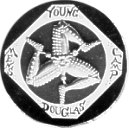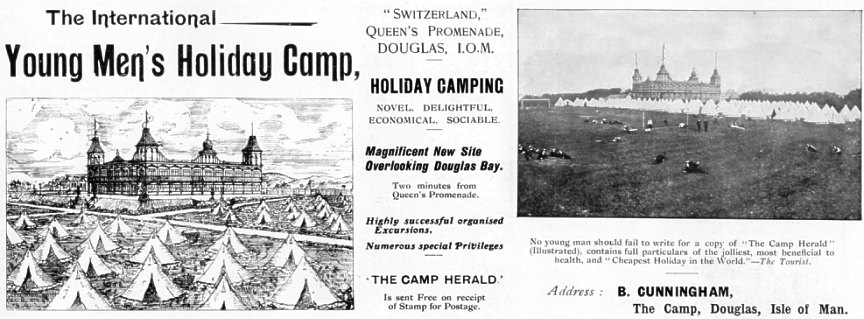 Cunningham's
camp
Cunningham's
camp Cunningham's
camp
Cunningham's
campFounded by Joseph Cunningham and wife Elizabeth; he was a Liverpool born flour dealer and baker, staunch Presbyterian and keenly interested in youth work who moved to the Island in mid 1890's, after encountering difficulties with his employers over organising (or rather subsidizing) a summer camp whilst superintendent of the Florence Institute in Toxteth, Liverpool. In 1892 and 1893 the Cunninghams had chosen Laxey as the venue for this camp but for 1894 had found a new site at Howstrake overlooking Groudle Glen. When the relationship with Florence Institute committee had deteriorated beyond repair, the Cunningham's decided to continue the camp under their own name and thanks to their business acumen made it into a highly profitable company.
|
|
His original, all male, tented city was established at Howstrake in 1894 which attracted up to 600 men per week. By the end of the century it was open from May till October, though the cost was now some 17/6 a week as opposed to the initial 10/- under the subsidized Toxteth scheme.
The success of this initial venture, greatly due to the organisational ability of Mrs Cunningham, led, in 1904, to the acquisition of 5 acres of agricultural land at Victoria Road (not too far from Falcon Cliff) where some 1500 tents and a hundred foot dining pavilion were erected for the March-October season. The Howstrake camp continued, though in other hands. |
|
 |
||
|
According to Douglas Centenary a tent could sleep up to eight men, spring beds being placed on a wooden floor (lifted every 10 days for cleaning). D Collister had the franchise to supply photos of the campers as well as general views of the camp etc. Press comment at the time was surprise at the class mixing that took place in the camp - its clientele were by no means only working class youth. The Cunninghams ran an efficient and very effective publicity machine that drew campers back each year. The "Camp Herald" was an annual advertising booklet issued as part of this machine. |
|
|
|
|
The camp grew its own vegetables and soft fruit - the card is sub-titled 'more jam' - possibly reflecting that the most popular meal in the dining hall was kippers and jam!. As the camp prospered the Cunninghams acquired more supporting services (e.g. Ellerslie farm in 1915 and modernised using Internee labour) so that it became almost entirely self supporting having its own dairy, pigs (fed from camp swill) etc. No alcohol was allowed on the camp, a rule that was strictly observed. Cunningham was an ardent temperance advocate throughout his life. |
|
|
Although Cunningham claimed that his visitors would not otherwise have come to the Island, the boarding house keepers claimed bitterly that he was unfairly undercutting them - especially as the rates he was paying on his 5 acres of 'agricultural land' were considerably lower than that of a typical boarding house!. There was also much disquiet about the morals of the campers - in 1911 a public meeting in the Town Hall, Douglas, was held to protest against the perpetuation of alleged illegalities at the Holiday Camp and later in that season a second agitation forced Douglas Borough council to introduce bye-laws to regulate such camps (including forbidding women to stay). |
|
|
|
|
As part of the agreement with the council Cunningham agreed to provide more permanent buildings but these considerably detracted from the appearance - the original wooden huts were replaced by chalets built by WW1 internees under supervision by local workmen, probably the first 'holiday' chalets built in the British Isles. Cunningham benefitted greatly by the use of this very low cost labour. |
|
|
Both Joseph Cunningham and wife went on to become pillars of Douglas society - he became scout leader on the Island, a member of the House of Keys after Mr. W.J. Corlett's death, and later was elected to the Legislative Council. ; he died in 1924 |
|
|
|
In September 1914 the Camp, cleared of its usual campers and staff, was requisitioned as an internment camp for enemy aliens - split into three: a privilege camp for those who could afford to pay for extra facilities (and also employ a prisoner servant), a Jewish camp and an ordinary section.
A riot in November 1914 (?Mar 1915 according to Kalkreuth) led to the death of 6 internees, most shot by the guards. A 1919 aerial photo shows the immediate post WW1 layout:
During WW2 the camp was again requisitioned, but this time to provide a training school for the Royal Navy - HMS St. George - which replaced all the pre war Boys training centres, the establishment also requisitioned the newly built Ballakermeen High School due to open in Sept 1939 to provide class rooms; HMS St George remained in Douglas until the end of 1945. Post war the family felt unable to rebuild the camp business - it was sold to a Blackpool business man but over the years became developed for housing and holiday accommodation. |
||
G. Kniveton (ed) Douglas Centenary 1896-1996 Manx Experience (ISBN 1-873120-21-4)
Jill Drower, Good clean fun: the story of Britain's first holiday camp London: Arcadia Books c1982 0-9508344-0-8
C. F. Denton "Life at Cunningham's camp" ManxMan #6 pp23/7 July 1912
F.E. Dunbar-Kaldreuth Die Männerinsel Paul Lift Verlag: Leipzig 1940 - has description of camp life 1916-1917
|
|
||
|
Any comments, errors or omissions
gratefully received The
Editor |
||